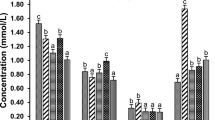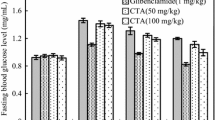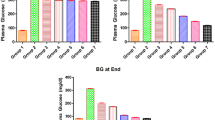Abstract
Traditional systems of medicine and medicinal plants research are the most promising areas of research in the modern drug discovery technologies. Today, drugs have taken their roots from the phytoconstituents. This study is aimed at the establishment of the hypolipidemic, hepatoprotective, and renal damage restoring efficacies of catechin isolated from Cassia fistula using bioassay guided fractionation on streptozotocin (STZ)-induced diabetic male albino Wistar rats. Catechin was administered to STZ (60 mg/kg b. wt)-induced diabetic male Wistar rats at 20 mg/kg b. wt for 45 days. Plasma glucose level was significantly reduced when compared with the control. In addition, oral administration of catechin significantly decreased glycosylated hemoglobin (HbA1C), serum total cholesterol, triglyceride, LDL-cholesterol, urea, uric acid, and creatinine, and at the same time, markedly increased hemoglobin, HDL-cholesterol, and serum protein. Catechin also restored the altered plasma enzymes (aspartate aminotransferase, alanine aminotransferase, alkaline phosphatase, and acid phosphatase) levels to near normal. Histological studies reveal that oral administration of catechin recovered the hepatic and renal damages. Results of this experimental study indicated that catechin possessed hypolipidemic, hepato-protective, and renal damage restoring efficacies, and hence, this could be used as an oral drug for treating diabetes and related diseases.


Similar content being viewed by others
References
Ahmad N, Mukhtar H (2001) Cutaneous photochemoprotection by green tea: a brief review. Skin Pharmacol Appl Skin Physiol 14:69–76
Akbarzadeh A, Norouzian D, Mehrabi MR, Jamshidi Sh, Farhangi A, Allah Verdi A, Mofidian SMA, Lame Rad B (2007) Induction of diabetes by streptozotocin in rats. Ind J Clin Biochem 22(2):60–64
Almdal JP, Vilstrup H (1989) Strict insulin therapy normalizes organ nitrogen contents and the capacity of urea nitrogen synthesis in experimental diabetes in rats. Diabetologia 31:114–118
Bakris GL (1997) Diabetic nephropathy, what you need to know to preserve kidney function. Postgrad Med 93:89
Berger SJ, Gupta S, Belfi CA, Gosky DM, Mukhtar H (2001) Green tea constituent (–)-epigallocatechin-3-gallate inhibits topoisomerase I activity in human colon carcinoma cells. Biochem Biophy Res Commun 8:101–105
Caraway WT (1955) Determination of uric acid in serum by carbonate method. Am J Clin Pathol 25(7):840–845
Chandramohan G, Ignacimuthu S, Pugalendi KV (2008) A novel compound from Casearia esculenta (Roxb.) root and its effect on carbohydrate metabolism in streptozotocin-diabetic rats. Eur J Pharmacol 590:437–443
Daisy P, Rajalakshmi M (2011) Hypoglycemic and insulin mimetic impact of catechin isolated from Cassia fistula: a substantiate in silico approach through docking analysis. Med Chem Res. doi:10.1007/s00044-011-9722-1
Daisy P, Balasubramanian K, Rajalakshmi M, Eliza J, Selvaraj J (2010) Insulin mimetic impact of Catechin isolated from Cassia fistula on the glucose oxidation and molecular mechanisms of glucose uptake on Streptozotocin-induced diabetic Wistar rats. Phytomed 17:28–36
Drabkin DL, Austin JM (1932) Spectrophotometric constants for common hemoglobin derivatives in human, dog and rabbit blood. J Biol Chem 98:719–733
Duncan BD (1957) Multiple range tests for correlated and heteroscedastic means. Biometrics 13:359–364
El-Demerdash FM, Yousef MI, El-Naga NI (2005) Biochemical study on the hypoglycemic effects of onion and garlic in alloxan-induced diabetic rats. Food and Chem Toxicol 43(1):57–63
Elsner M, Guldbakke B, Tiedge M, Munday R, Lenzen S (2000) Relative importance of transport and alkylation for pancreatic beta-cell toxicity of streptozotocin. Diabetologia 43:1528–1533
Fawcett JK, Scott JE (1960) A rapid and precise method for determination of urea. J Clin Pathol 13:156–159
Fujiki H, Suganuma M, Okabe S, Sueoka N, Komori A, Sueoka E, Kozu T, Tada Y, Suga K, Imai K, Kei Nakachi (1998) Cancer inhibition by green tea. Mutat Res 402:307–310
Furuse M, Kimura C, Mabayo RT, Takashi H, Oicumura J (1993) Dietary sorbose prevents and improves hyperglycemia genetically in diabetic mice. J Nutr 123:59–65
Graham H (1992) Green tea composition, consumption and phenol chemistry. Pre Med 21:334–350
Humason GL (1979) Animal tissue techniques. WH Freeman and Company, San Francisco
Ji BT, Chow WH, Hsing AW, McLaughlin JK, Dai Q, Gao YT, Blot WJ, Fraumeni JF Jr (1997) Green tea consumption and the risk of pancreatic and colorectal cancers. Int J Cancer 70:255–288
Jyoti M, Vihas TV, Ravikumar A, Sarita G (2002) Glucose lowering effect of aqueous extract of Enicostemma Littorale Blume in diabetes: a possible mechanism of action. J Ethnopharmacol 81:317–320
Kind PRN, King EJ (1954) Estimation of plasma phosphatases by determination of hydrolyzed phenol with amino-antipyrine. J Clin Pathol 7:322–326
Liu IM, Tzeng TF, Liou SS, Chang CJ (2009) The amelioration of streptozotocin diabetes-induced renal damage by Wu-Ling-San (Hoelen Five Herb Formula), a traditional Chinese prescription. J Ethnopharmacol 124(2):211–218
Lowry OH, Rosebrough NJ, Farr AL, Randall R (1951) Protein Measurement with the Folin Phenol reagement. J Biol Chem 193:265–275
Maiti K, Mukherjee K, Gantait A, Ahamed HN, Saha BP, Mukherjee PK (2005) Enhanced therapeutic benefit of quercetin-phospholipid complex in carbon tetrachloride induced acute liver injury in rats: a comparative study. Iran J Pharmacol and Therap 4:84–90
Mauer SM, Steffes SW, Brown DM (1981) The kidney in diabetes. Am J Med 70:603–612
Mitscher LA, Jung M, Shankel D, Dou JH, Steele L, Pillai S (1997) Chemoprotection: a review of the potential therapeutic antioxidant properties of green tea (Camellia Sinensis) and certain of its constituents. Med Res Rev 17:327–365
Moss DW (1984) In: Bergmeyer HU (ed) Methods of enzymatic analysis, vol 4, 3rd edn. Verlag-chemic, Berlin, pp 92–106
Nagarajan S, Nagarajan R, Braunhut SJ, Bruno F, McIntosh D, Samuelson L, Kuma J (2008) biocatalytically oligomerized epicatechin with potent and specific anti-proliferative activity for human breast cancer cells. Molecules 13:2704–2716
Navarro C, Montilla PM, Martin A, Jimenez J, Utrilla PM (1993) Free radicals scavenger and antihepatotoxic activity of Rosmarinus. Plant Med 59:312–314
Ohaeri OC (2001) Effect of garlic oil on the levels of various enzymes in the serum and tissue of streptozotocin diabetic rats. Biosci Rep 21:19–24
Osakabe N, Yamagishi M, Sanbongi C, Natsume M, Takizawa T, Osawa T (1998) The antioxidative substances in cacao liquor. J Nutr Sci Vitaminol 44:313–321
Quine SD, Raghu PS (2005) Effects of (–)-epicatechin, a flavonoid on lipidperoxidation and antioxidants in streptozotocin-induced diabetic liver, kidney and heart. Pharmacol Rep 57(5):610–615
Rajkumar L, Srinivasan N, Balasubramanian K, Govindarajulu P (1997) Increased degradation of dermal collagen in diabetic rats. Indian J Exp Biol 29:1081–1083
Ravi K, Rajasekaran S, Subramanian S (2005) Antihyperglycemic effect of Eugenia jambolana seed kernel on streptozotocin-induced diabetes in rats. Food Chem Toxicol 43:1433–1439
Reitman S, Frankel SA (1957) Colorimetric method for the determination of serum glutamate oxaloacetic and glutamate pyruvic transaminases. Am J Clin Pathol 28(1):56–63
Soltani N, Keshavarz M, Dehpour AR (2007) Effect of oral magnesium sulfate administration on blood pressure and lipid profile in streptozotocin diabetic rats. Eur J Pharmacol 560:201–205
Song EK, Hur H, Han MK (2003) Epigallocatechin gallate prevents autoimmune diabetes induced by multiple low doses of streptozotocin in mice. Archives of Pharmacal Res 26(7):559–563
Thielecke F, Boschmann M (2009) The potential role of green tea catechins in the prevention of the metabolic syndrome—a review. Phytochem 70(1):11–24
Tuvemo T, Ewald U, Kobboh M, Proos LA (1997) Serum magnesium and protein concentrations during the first five years of insulin-dependent diabetes in children. Acta Paediatr Suppl 418:7–10
Wan Y, Vinson J, Etherton T, Porch J, Lazarus S, Kris-Etherton P (2001) Effects of cocoa powder and dark chocolate on LDL oxidative susceptibility and prostaglandin concentration in humans. Am J Clin Nutr 74:596–602
Acknowledgments
The financial support extended by the University Grants Commission (Project no. 32-505/(SR) is acknowledged. This project is supported by the DBT (Department of Biotechnology), Government of India, New Delhi.
Author information
Authors and Affiliations
Corresponding author
Rights and permissions
About this article
Cite this article
Pitchai, D., Manikkam, R. Hypolipidemic, hepato-protective and renal damage recovering effects of catechin isolated from the methanolic extract of Cassia fistula stem bark on Streptozotocin-induced diabetic Wistar rats: a biochemical and morphological analysis. Med Chem Res 21, 4535–4541 (2012). https://doi.org/10.1007/s00044-012-9989-x
Received:
Accepted:
Published:
Issue Date:
DOI: https://doi.org/10.1007/s00044-012-9989-x




